 Key to Gilled Mushrooms Key
Key to Gilled Mushrooms KeyThis is a key to gilled mushrooms, that is, mushrooms having a definite cap with a fertile surface consisting of gills. The fruiting body usually also has a stem, although that may be lateral or absent (usually, then, the mushroom is growing from wood). You can use this key to identify mushrooms that you find.
Polyporaceae Family
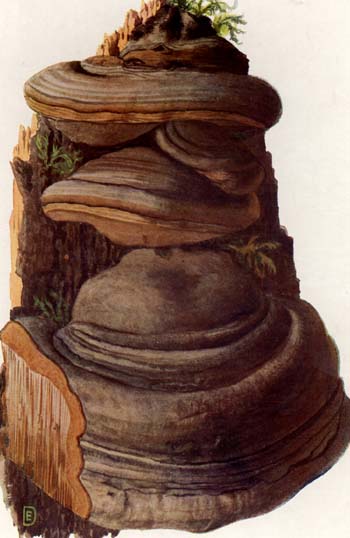
Diagnosis
- Fertile surface usually a layer of vertical tubes, of which the mouths are visible as pores on the underside of the cap or shelf.
-
Fruiting bodies usually tougher or harder than the "normal" gilled mushrooms, being leathery, corky, or woody. But they can be quite tender while actively growing
-
Once grown, they do not decay easily, remaining on the substrate for months or years
-
They often grow on wood, although a few are terrestrial (even those are usually growing on buried wood)
-
Fruiting body is usually a flat shelf, or hoof-shaped, protruding directly from the substrate, although sometimes it may have a short stalk.
-
Some forms never grow away from the substrate at all, so that all that is visible of the fruiting body are the pores.
-
Sometimes the pores are so minute that the fertile surface seems solid, until you look closely
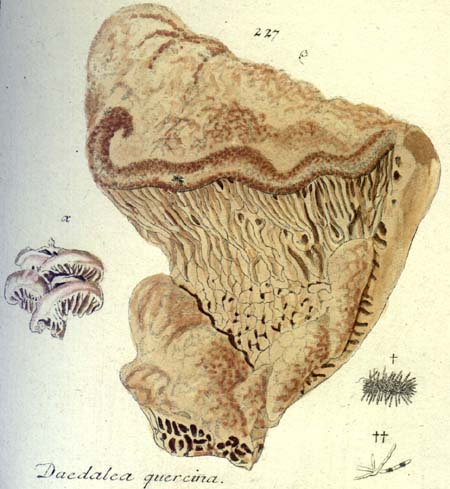
- In some genera, the walls between some of the pores may be eroded or absent, so that the fertile surface is composed of plates (sometimes very wandering or maze-like) rather than pores; but in this case the plates are very hard and woody, not like the flexible fleshy plates that characterize the gilled mushrooms
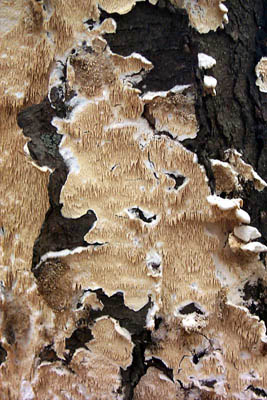
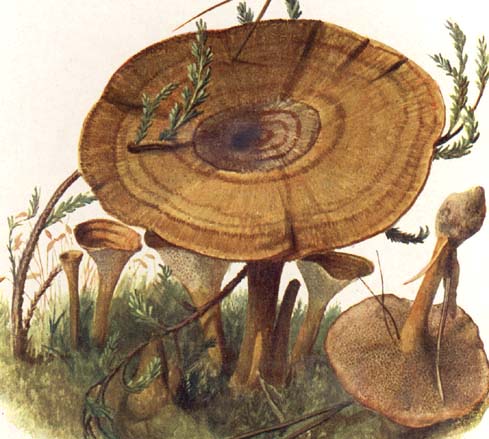
- Some polypores are terrestrial, and these may be confused with the Boletaceae. The field character most commonly used to distinguish them is detachability of the pores: in the Boletaceae, the pores can usually be peeled cleanly away from the cap; in the Polyporaceae, the cap and the flesh are continuous with one another, and you can't pull the pores off without tearing the flesh of the cap. But some polypores, like Polyporus radicatus will cleanly separate, so they are also keyed out under the Boletaceae
-
Another developmental feature is that in the Boletaceae the pores develop before the cap opens; in the Polyporaceae, the pores grow after the cap opens, so you can sometimes catch polypores with a fully developed cap having a solid layer of tissue underneath it. If you find something like that, you have either a Stereum or a young polypore.
-
Finally, bolete tube walls have divergent trama; polypore tubes do not.
Narrow down your identification:
 Echinodontium Genus
Echinodontium Genus- Fertile surface composed of long (typically 2-3") spines.
-
Fruiting body hard (woody).
-
The top of the cap is usually a dark basic color (like the picture), with bright red and orange flesh and spines
 Lignicopolypore Subfamily
Lignicopolypore Subfamily
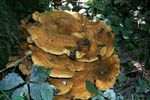 Terrestriopolypore Subfamily
Terrestriopolypore Subfamily






 Key to Gilled Mushrooms Key
Key to Gilled Mushrooms Key



 Echinodontium Genus
Echinodontium Genus




